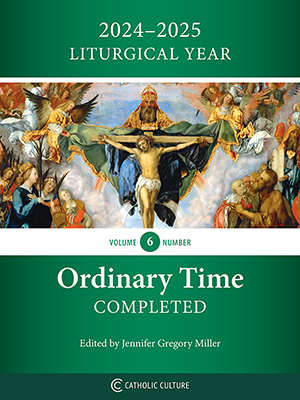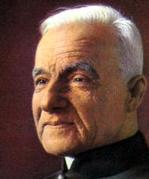All things visible and invisible
By Phil Lawler ( bio - articles - email ) | Aug 26, 2025
These words should look familiar:
Free eBook:

|
| Free eBook: Liturgical Year 2024-2025, Vol. 6 |
I believe in one God,
The Father almighty
Maker of heaven and earth,
Of all things visible and invisible
The emphasis is mine, but the placement of that profession at the very start of the Nicene Creed should be enough to drive home the message. The Christian faith rejects the post-Cartesian conceit that everything real can be seen and felt, counted and measured. What we know, what we believe, and what we profess are not confined to what we can quantify.
Love is a reality, for instance, as is pain. They are not visible. But we can see their effects, and so we know that in some cases, at least, what is invisible drives what is visible.
Earlier civilizations generally believed that our lives were governed by forces that could not be seen: by the movement of the planets or the whims of the gods or the blessings and curses of long-dead ancestors. Christians as well as pagans took it for granted that our lives could be influenced by spirits, good and evil, who could interact with us without being detected. Today that sort of belief is not quite respectable—although, significantly, it is enjoying a new popularity in New Age fads and a resurgence of outright paganism.
Haven’t most of us had experiences that pointed toward some sort of mysterious forces acting upon us? We have premonitions of events that have not yet occurred. The phone rings, and we know, inexplicably, who is calling and what he is going to say. Or during an entirely novel experience, we have that odd sense of déjà vu. We dream about a long-lost old acquaintance, and the next day meet him on the street. Such occurrences are rare, but when they happen they are hard to dismiss.
People who survive near-death experiences sometimes report that they could see the doctors working on them, and see their relatives nervously gathered in the waiting room, while their bodies lay inert on the operating table. Others recall, with detailed accuracy, what was happening in a completely different location—a place where they had never been. Some twins claim that they can sense each other’s emotions remotely. Any of these claims might easily be dismissed as fanciful, but can we discount them all?
Physicists tell us that subatomic particles have a relationship remarkably similar to the one that some twins discover. Once paired in what is known as “quantum entanglement,” the particles will continue to influence each other, even if they are separated by thousands of miles. Albert Einstein referred to these phenomena as “spooky actions at a distance.” If they happen in quantum physics—if they help physicists explain natural processes—why couldn’t “spooky actions at a distance” explain some of the things that happen to humans as well?
Of course physicists have not yet explained the spooky actions; they have only described them. Einstein never realized his ambition to discover the Grand Unified Theory that would reconcile the findings of quantum mechanics with his own theory of relativity, nor have any of his successors found the explanatory key. The mathematical formulas that support relativity theory do not work for quantum theory, and vice versa. So the search continues for a full explanation of the forces that govern the physical universe.
In my own (unsuccessful) bid to understand quantum theory, I stumbled across a report that some physicists had found a way to make the formulas work—provided that the universe has nine dimensions. That possibility took me aback. What if we are living in a world in which our crude human senses only perceive a few of the dimensions that exist. Then we might plod our way through time and space, noticing only a slim slice of reality, utterly ignorant of—whatever those other dimensions might be.
To continue the speculation (and I emphasize that it is speculation), could there be dozens of angels dancing around me as I write, and around you as you read, undetected by our senses? Why not? There are angels. Consider how much of the Summa Theologica St. Thomas devotes to his discussion of the angels, apparently confident not only that these creatures exist but also that they are worth understanding. We do not often think about angels. (Perhaps, unless we think of ourselves as much more intellectually sophisticated than St. Thomas, we should think of them more often.) But they exist, and their actions may help to explain some of the “spooky actions” that we do notice from time to time. They do not often enter into our lives—or perhaps it would be more accurate to say they do not often leave evidence that we can detect—but every now and then they make themselves manifest.
But now again I am afraid that I am explaining my idea badly, because I may be giving the impression that the angels exist in a different world, or at least a different dimension, when in fact I mean that they are living right here, with us, in a world that would seem all the more real and even familiar to us if we could only perceive things clearly. C. S. Lewis conveys the idea in his Space Trilogy, with the eldils who eventually become visible to an enlightened visitor from Earth.
Especially if there are multiple dimensions to our universe still undiscovered, we need not confine our speculation to angels. The saints, the prophets, the faithful departed are all still a part of our lives, and “since we are surrounded by so great a cloud of witnesses,” we would be foolish to underestimate their influence. Sometimes—very rarely, but still often enough to command attention—they make their presence known.
The Bible recounts many occasions on which humans come face to face with the supernatural. None is more dramatic than the account of the Transfiguration, when the apostles see Jesus conversing with Moses and Elijah. It is striking that the apostles recognize Moses and Elijah; somehow, as they are lifted beyond ordinary human vision, they are also given special insight. They are utterly overwhelmed by the experience, and Peter irrationally suggests making booths—literally walling up Moses and Elijah within the physical limitations they have left behind. Still the apostles have been blessed and strengthened with a glimpse into the more vivid reality that lies beyond our ordinary human perceptions.
So when Peter and James and John come back down the mountain, back to the mundane, they are unable to forget what they have seen: the fuller, more glorious world of the promise, the world of the supernatural, which with Christ’s help they can enter.
And so can we, conscious that we already live in this world surrounded by angels and saints who cheer us on. Here on earth we cannot expect to see the unveiled glories, that the apostles saw at the Transfiguration. But we know they are there to be seen, and we know that with the Lord’s help, someday we may see them. So we can pray, in the words of the hymn for that feast:
… since you bid us leave the mount,
Come with us to the plain.
All comments are moderated. To lighten our editing burden, only current donors are allowed to Sound Off. If you are a current donor, log in to see the comment form; otherwise please support our work, and Sound Off!







